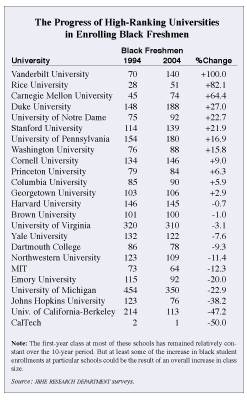| Tracking Black Student First-Year Enrollments Over the Past Decade at the Nation's Highest-Ranked Universities Of the nation's leading universities, Vanderbilt University has shown the most impressive progress in increasing black freshman enrollments over the past decade. Huge declines have occurred at Berkeley, Johns Hopkins, and the University of Michigan.
Each autumn for the past 12 years JBHE has surveyed the admissions offices of the nation's high-ranking universities to determine the number of black applicants, accepted black students, and the number of black first-year students who actually enroll at these institutions. Our database permits us to examine the enrollment trends to see which high-ranking universities are making the most progress in increasing the number of black students on campus. The accompanying table shows the number of black freshmen admitted to the nation's 25 highest-ranking universities in both 1994 and 2004. (The University of Chicago, ranked among the top 25 universities nationally, declined to participate in our 2004 survey, so data for only 24 universities is shown.) Overall, 12 universities posted an increase in black first-year enrollments during the period and 12 universities showed a decline. The largest increase in both actual numbers and in percentage terms occurred at Vanderbilt University in Nashville, Tennessee. Black first-year enrollments doubled during the period from 70 in 1994 to 140 in 2004. Rice University, where black enrollments have fluctuated widely in recent years, showed an increase of 82 percent in the 1994 to 2004 period.
Carnegie Mellon University in Pittsburgh, an institution where a large segment of the student body is engaged in the study of the sciences, posted a healthy gain in black enrollments of 64.4 percent. But it must be pointed out that in 2004 blacks were still only 5 percent of the entering students at the university. Duke University has steadily increased black enrollments in recent years. In 2004 Duke had the highest percentage of black freshmen of any of the nation's highest-ranked universities. Some 11.5 percent of all black freshmen at Duke this past academic year were blacks. At Stanford University black enrollments increased nearly 22 percent in the 1994 to 2004 period. But in 2004 black first-year enrollments were down 31 percent from 2003. If we examined black first-year enrollments at Stanford in the 1994 to 2003 period, the university would have posted an overall gain of 78 percent. One note of caution: the Stanford example demonstrates that there can be substantial fluctuations in enrollment figures from one year to the next. But the data does offer a snapshot of university progress in increasing black enrollments over a specific time period that gives a good indication of the overall trend. Universities Showing a Decline in Black Enrollments In the 1994 to 2004 period 12 of the nation's highest-ranked universities showed a decrease in black first-year enrollments. At the California Institute of Technology, the number of black students is so insignificant that percentage comparisons are almost meaningless. Black first-year enrollments during the decade have ranged from zero to four. The numbers are so small that depending on what year one chooses the percentage can show a rise of 200 percent or a drop of 50 percent. More meaningful are the large decreases in black students at Johns Hopkins University, the University of Michigan, and the University of California at Berkeley. At Johns Hopkins black first-year enrollments have fluctuated widely over the period, but the overall trend is down significantly. At the University of Michigan the undergraduate admissions plan, which assigned positive points to black applicants, was declared unconstitutional in June 2003 by the U.S. Supreme Court. Since that time there has been a huge drop in black first-year enrollments. But the decline in black enrollments had begun even before the Supreme Court's decision. In 2001 blacks were 9 percent of all incoming freshmen. In 2004 blacks were only 5.8 percent of the first-year class. Since 1994 black first-year enrollments are down nearly 23 percent. But without a doubt the most discouraging news on black enrollments is at the University of California at Berkeley. In 1994, the year before the University of California's board of regents voted to ban race-sensitive admissions, there were 214 black freshmen on campus. This year there were 113. This is a decrease of more than 47 percent. Blacks were only 3 percent of all freshman students at Berkeley this past academic year. Preliminary admissions figures for the class that will enter this fall does not offer any evidence that the number of blacks in the first-year class will be substantially different from a year ago. | |




